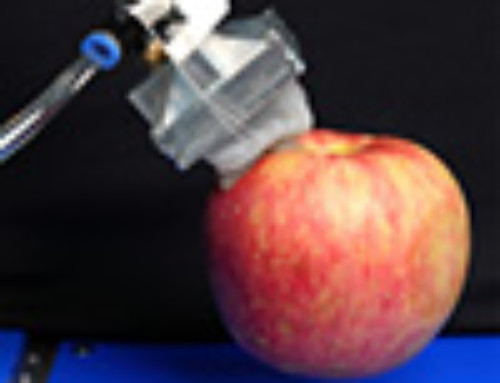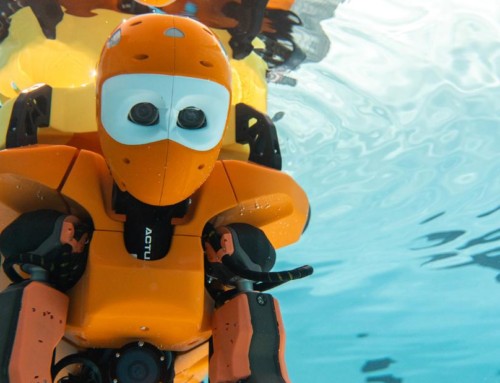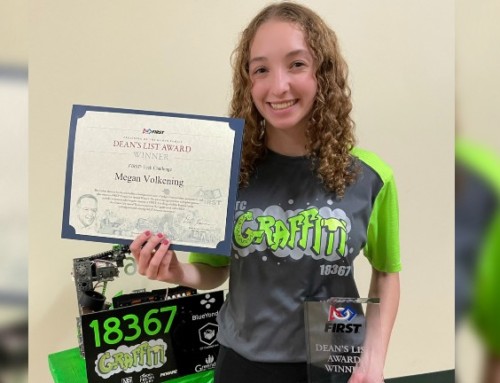[ad_1]
Robots and drones have long tackled tasks that are dangerous for humans, and now they can add another item to the list – exploring the waters under the ice shelf in Antarctica.
A team from New Zealand startup Boxfish Research completed a five-week stay in Antarctica, assisting Dr. Regina Eisert and a research team from the University of Canterbury. The research team was participating in the Antarctic Top Predator program, with the goal of studying and capturing footage of the Orca and Minke whales as they congregated in the ice channel that resupplies the McMurdo research station.

Ben King, Boxfish Research
Boxfish Research Co-founder Ben King and his team supplied the scientists with the Boxfish ROV and Boxfish 360 underwater vision systems, designed to handle extreme weather conditions.
Robotics Business Review recently spoke with King about the journey to Antarctica and the lessons learned for using underwater drones in harsh conditions.
Origins of the project
Q: Give us a quick background on how this all started and how Boxfish Research got involved in the project.
King: Boxfish Research is a premium mini-RV manufacturer located in New Zealand. We make an ultra-maneuverable underwater drone that is specifically designed for working in tough conditions and capturing ultra-high-definition video, with cinema quality. One of the scientific researchers, Dr. Regina Eisert got in touch with us about how she could get some of our equipment down there. We came to an arrangement to collaborate on the project so I could join the team and be on the ground down there in Antarctica.
Q: What were they hoping to get out of the project from using the drone? Was it just video, or other types of data?
King: At this stage, their research focuses on the top predators in Antarctica, primarily Type C killer whales and Minke whales, and they’re particularly interested in feeding behavior, social behavior and range. This is done in order to better understand the overall fishery and biomass in the Ross Sea region as part of the marine protected area. Having eyes under the water is an amazing way to get a better understanding of the social behavior of the animals, and ideally the feeding behavior as well.

Whales spotted in Antarctica. Source: Ben King, Boxfish Research
Q: Did they have any sensors that they wanted to use on your equipment to measure water data, temperature, things like that?
King: No, because this project came together rather quickly. We didn’t have time to integrate anything additional, but certainly for future years there’s discussions already in place about returning next summer for hydrophone recordings and other aspects of research down there, like studying the bottom around Scott which would benefit from USBL [ultra-short baseline underwater acoustic positioning] and other navigation systems to have a better geo-reference for all the footage.
Getting to Antarctica
Q: How long did it take do get the project rolling? Were there a lot of hoops to jump through in order to get to Antarctica?
King: We thought that it would, but it all happened remarkably quickly, and that’s why we didn’t have a chance to integrate any additional equipment. The first mention of us doing this was in late August, and we had to ship the gear in November down to the ice. We’re a small company, so we just did everything we could to get the gear we had ready to go down to the ice.
Q: How long did it take for you to get to Antarctica from New Zealand?
King: I flew to Christchurch, got kitted out with all my cold weather gear for Antarctica, and then stayed overnight and we left the next day. But one of the team members got bumped off the flight and ended up taking five days before he got there because of the weather conditions. Getting to and from Antarctica is the real challenge – some people can be delayed up t o a week or more in some extreme cases.
Q: Did you have to do any other kind of special training to be ready for those weather conditions?
King: Everyone that goes to Antarctica with the New Zealand Antarctic program is given filed training, it’s basically a 24-hour course on the ice, camping out, eating dehydrated food and learning how to survive basically in case you get stuck out there for whatever reason. It was good fun.
I have a lot of outdoor experience myself. It was a fairly comfortable environment, but that’s not the case for all. The staff down there did a fantastic job of really making sure that everybody had the skills and the equipment and the support they needed to operate safely.
Q: Once you got there, how long were you there with the research team?
King: About five weeks in total. We were working with night operations. We traveled each night from the base to McMurdo Station, where the helicopter pad is, and the New Zealand Helicopter, and we flew out to the ice at about 10 p.m. each night and were back at the base at about 9:30 a.m.

The research team traveled by helicopter to reach its location for the dives. Source: Ben King, Boxfish Research
Q: Was there a particular reason why you were conducting the research at night? Was it because that’s when the whales were likely going to be in the area?
King: There were a number of reasons. We were able to have close support from the helicopters so they could stick with us for the entire evening, because there’s very little going on at night, so we had our own pilot. The light is better for doing photo identification above the water because the sun is a bit lower. And the whales do seem to be most active around then – they talked about ‘whale o’clock’, between 10:30 p.m. and 12 a.m. – we’d often see a lot of whales where they’d become very active.
Extreme weather, rugged conditions
Q: From your company’s standpoint, what were some of the goals you were hoping to attain? Was it to see whether the equipment could withstand these temperatures and weather extremes? Was it to see if you could achieve high quality video?
King: Our goal was basically to get the ROV out in the field and use it as much as possible and capture the most stunning footage we possibly could. In addition, we wanted to get field experience in such an extreme environment with our equipment.
We exceeded all expectations on all fronts. The equipment performed exceptionally well. We had no loss of dive time because of equipment failure at all. We had 100% uptime, which was amazing. We did 15 dives with 21 hours under the water, down to 210 meters (about 700 feet).
We also spooled our entire tether out – we had 440 meters of tether that we maxed out – we pushed everything. The ROV was handled about 10 times a day in and out of vehicles, and into helicopters and out of helicopters and across the ice and back. It stood up to that really, really well.
The cold weather didn’t affect the performance, and we were able to stay underwater longer than what the humans could endure above the water.
We were also able to do a world’s first – we did a live dive in the bar at Scott Base. We convinced the telecom tech to loan us 500 meters of fiber optic cable that we rolled it out across the ice to the hole where we were diving, when we couldn’t get out to the ice edge with the helicopter. I was able to pilot the ROV from inside the bar, so that was pretty cool.
One of the bonuses of the trip was that when we weren’t out with the whales, we had this hole so we could just go out there and dive. It was about 66 meters deep at the hole, and about 100 meters offshore. From there we could explore the sea floor, which was just teeming with life – creatures and critters and fish and octopus and sponges – all manner of life.
Q: Did any issues or challenges pop up where you needed to adapt quickly, being in Antarctica without having to drive to a store to get gear?
King: Probably the most annoying thing was when we did the first dive, we found the friction increased slightly, and the tether rail made it a little bit challenging to wind in on the snow. So I got the carpenter to help me make a plywood base plate that we strapped the tether reel to, and then we just screwed it down to the ice each day with ice screws, and that completely solved the problem. It was a really minor thing, but a very simple solution and we were good to go.
How robots can help researchers
Q: What message do you want to bring to customers that might be thinking about deploying these types of systems?
King: What we really proved – and I even proved to myself – was just how incredible the propulsion system is that we have on our ROV, coupled with the really high-end video. The eight-vectored thruster propulsion system really gives you full freedom to capture the footage.
The perfect example was outside Scott Base. There was always a reasonably strong current, and it didn’t affect operations because I was able to maneuver the ROV as if there wasn’t any current, simply because we can direct that thrust in any direction. So I could pan around an object simply by compensating for the current as I moved, which was very easy to do. I just really saw the power of that.
Additionally, the fact that the sea floor was sloping at about a 40-degree angle and that I could just pitch the entire vehicle down to look at the sea floor – made it really amazing to be able to just move around under there with total freedom.
Q: Have you been able to step back and really appreciate the type of opportunity you had in visiting Antarctica?
King: Oh, absolutely. I’ve been looking through the footage, and we have been slowly releasing it – it’s just incredible. At first everyone was telling us that you don’t achieve any results in your first season – it’s always treated as a pilot. We obviously didn’t go into it with that mindset, but what I discovered is that it’s a common way of looking at it – the scientists have that kind of attitude, which was a bit surprising. But we certainly didn’t come home feeling like we needed to think that way.
Q: But on the other hand, you want to go back, correct?
King: Absolutely. There’s always more to capture. We got some stunning footage of penguins swimming through the water, and we also want to work with other scientists. Antarctica specifically, there’s so much we could have done – exploring the ice sheet, there’s people looking at ice. We can put a manipulator on the ROV to grab samples – we could do gas samples from some of the volcanic vents. We’re talking to a guy about sponges to take core samples of the sponges. We could do push cores in the sediment – there’s all kinds of things we could do over and above capturing the fantastic video.
Q: So how cold did it get?
King: In the water it was -2 C (28.4 F). The lowest temperature before we put the ROV in the water was –6 C (21.2 F) from it sitting out in the cold. And the air temperature, the coldest we had was -14 or -15 (about 5 F), and with the wind chill it was well below -20 C (-4 F).
[ad_2]
Source link





Leave A Comment
You must be logged in to post a comment.